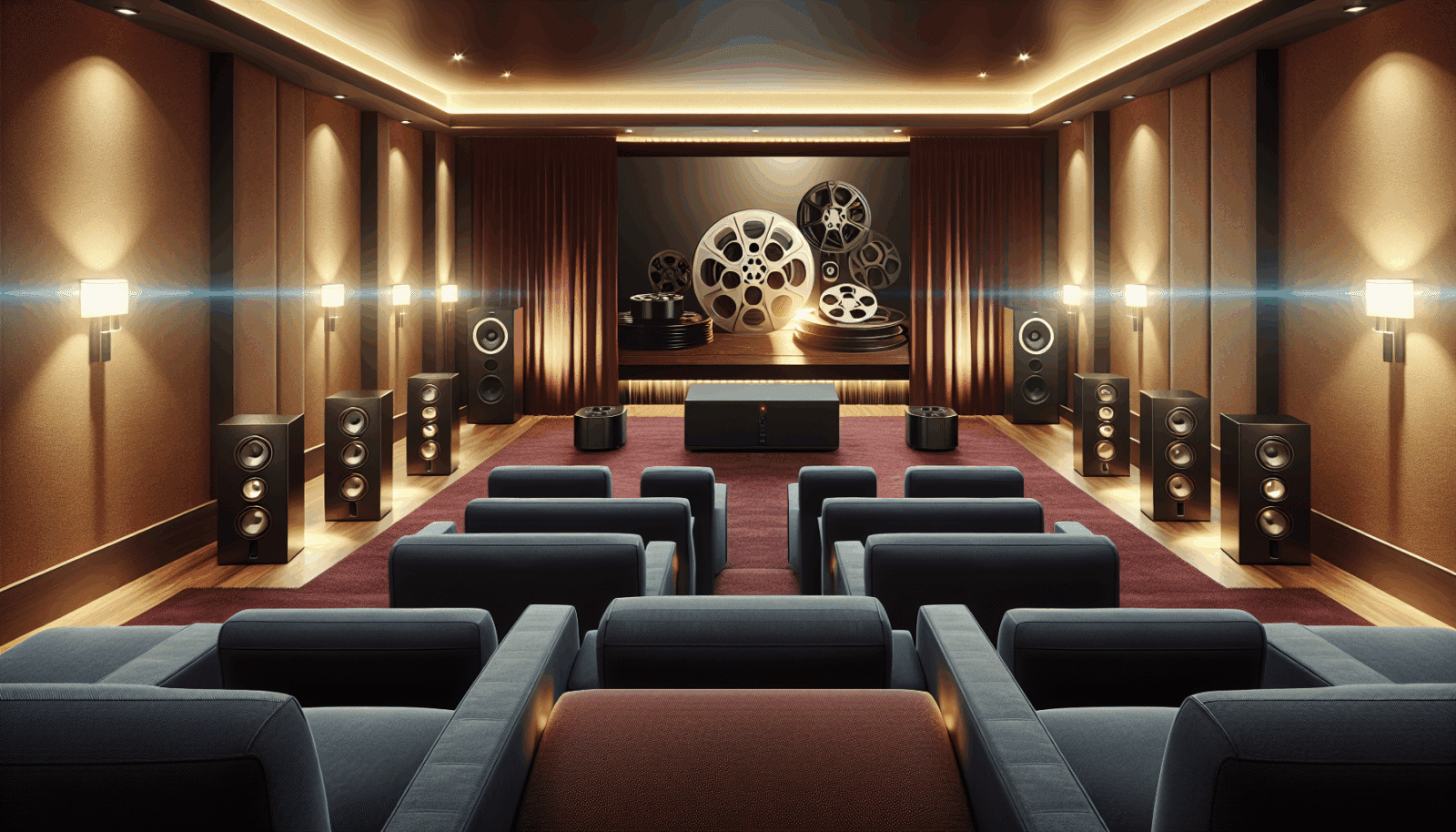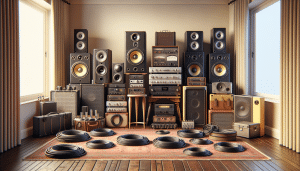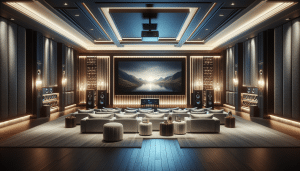Optimizing your home theater speaker placement can make all the difference between a mediocre movie night and a full-blown cinematic experience. At AZP Home Theaters & Automation, we know that every homeowner desires superior sound that brings movies and music to life. If you’ve been struggling to achieve the perfect balance of sound in your home theater, this article is designed to guide you through the process. We’re here to help you create a harmonious audio environment that turns your home theater into an entertainment masterpiece.
Understanding Speaker Types for Your Home Theater
Before diving into the nitty-gritty of speaker placement, it’s essential to know the types of speakers you’ll be working with. Each speaker plays a unique role in delivering sound, so understanding their purpose can optimize your placement strategy.
First, let’s talk about front speakers. These are your main sound providers and typically consist of left, right, and center channels. The front speakers handle most of the dialogue and action sounds, so they need proper placement for an immersive experience.
Next, consider your surround speakers. Positioned to envelop the listener, surround speakers create a sense of space by delivering ambient and background sounds. Finally, there’s the subwoofer, responsible for those heart-pounding bass effects. Each of these speakers requires meticulous placement, which we’ll explore in detail further on.
Finding the Ideal Listening Position
It may seem surprising, but the first step in optimizing your speaker placement involves determining your ideal listening position. This spot is referred to as the “sweet spot” and is crucial for achieving balanced sound.
Typically, the sweet spot is where you’ll primarily enjoy your home theater, usually directly facing the center speaker. From here, you’ll want to angle your front speakers accordingly to aim the sound directly at this position. Consider the height as well; having the speakers at ear level when seated ensures clarity.
By starting with your listening position, you’ll have a solid foundation for placing the rest of your speakers, ensuring a seamless audio journey.
Strategic Placement of Front Speakers
Now that we’ve pinpointed the sweet spot, it’s time to position those vital front speakers. Their placement can make a massive difference in the clarity of dialogue and effects.
Begin by placing your left and right speakers equidistant from the center channel speaker, making a triangle shape with your sweet spot. While doing this, it’s essential to keep the left and right speakers at an equal height and distance, which helps in balancing the soundstage effectively.
Meanwhile, your center channel ideally sits just above or below your display, horizontally aligned to maintain the continuity of on-Screen dialogue. This positioning ensures that voices appear to originate from the screen rather than from the sides.
Importance of Surround Speaker Placement
Surround speakers hold the power to transform your experience from one-dimensional to immersive. Proper placement is crucial to achieving this enveloping sound.
For 5.1 systems, place your surround speakers to the side and slightly behind your listening position. The goal is to wrap sound around the listener, creating an immersive soundscape. When you upgrade to a 7.1 system, consider adding rear speakers directly behind your seating area for an extra layer of dimension.
Elevation can also play a role. Positioning surround speakers above ear level can simulate the theater experience, where sound comes from all directions. This method is particularly effective in larger rooms needing a broader sound reach.
Mastering the Subwoofer’s Location
The subwoofer is unique because sound waves in its range are less directional. This means placement is flexible yet critical for optimal bass distribution.
A subwoofer can be placed at the front of the room for a straightforward setup or even a corner for enhanced bass. Be prepared to experiment with placement, as room acoustics significantly affect low-frequency performance.
One popular strategy is the subwoofer crawl. Place the subwoofer in your desired listening position and walk around the room. Stop where the bass response sounds the best and place your subwoofer there for a richer, more dynamic performance.
Balancing the Sound with Acoustic Treatments
No home theater is complete without considering the acoustic properties of the room. Acoustic treatments can fine-tune your listening experience beyond speaker placement.
Start by analyzing your room’s surfaces. Walls, floors, and ceilings all impact acoustics. Utilizing sound-absorbing materials like carpets, curtains, and wall panels can minimize echoes and sound reflections.
Additionally, diffusion panels can scatter sound waves, providing a more open soundstage. By combining absorption with diffusion, you enhance clarity and prevent overpowering echoes or dead spots.
Exploring Advanced Speaker Configurations
Once you’ve mastered basic placement, delve into advanced setups like Dolby Atmos. These systems can elevate your home theater to professional levels of sound precision.
Dolby Atmos utilizes height effects speakers, which are installed in the ceiling or upward-firing to produce overhead sounds. This arrangement contributes to a more dynamic soundscape, adding another layer of immersion to your listening experience.
Configuring advanced setups demands attention to detail and proper calibration. Don’t shy away from enlisting professional help to navigate this complex task.
Tweaking the System with Calibration
Speaker placement is just one piece of the puzzle; calibration ensures each component performs at its peak.
Begin the calibration process with your AV receiver’s auto-calibration feature if available. This tool can automatically adjust speaker levels, distances, and frequencies to match your room’s acoustics.
Manual calibration is equally beneficial. Using a decibel meter and a calibration disc, fine-tune each speaker to achieve uniform sound pressure levels. Proper calibration ensures that each speaker balances with others, providing a harmonious Surround Sound experience.
Understanding the Role of Wiring and Connectivity
Behind every powerful sound system lies efficient wiring and connected components. The quality of wiring and connectivity affects overall sound performance.
Invest in quality cables that minimize resistance and maintain signal integrity. Opt for sufficiently long cables to keep room arrangements flexible without compromising on quality.
Connectivity plays a crucial role, too. Wireless systems retain the clean aesthetics of your home, while traditional wired systems offer unrivaled reliability. Whichever you choose, keeping connections secure and organized is key to maintaining a clutter-free setup.
Testing and Enjoying Your Optimized System
Finally, it’s time to enjoy the fruits of your labor. Testing out your newly set up home theater system is an exciting venture.
Choose a variety of content to play through the system, covering films with dynamic sound editing, music with nuanced production, and games that demand accuracy. This broad testing range ensures that your system performs exceptionally across all media.
Invite family or friends to enjoy your optimized setup and relish the sound quality. Any final adjustments can be a fun, interactive way to discover your system’s fullest potential.
Ready to elevate your home theater experience? Reach out to us by phone # 385-475-3549 or Request a Free Quote. Discover just how thrilling your home entertainment can be!




